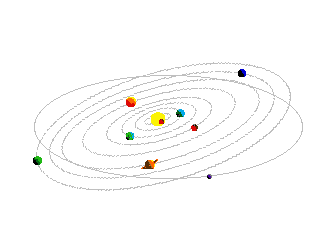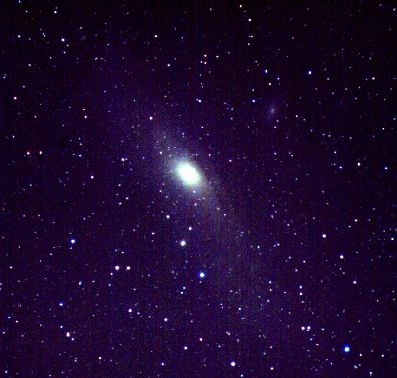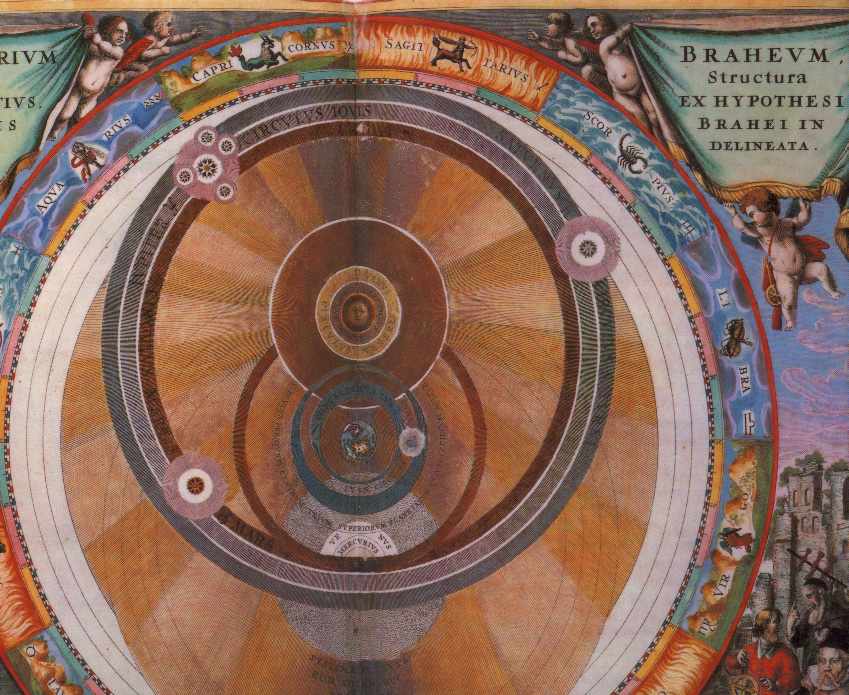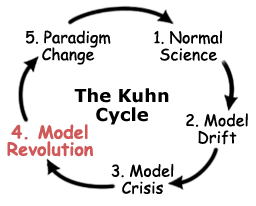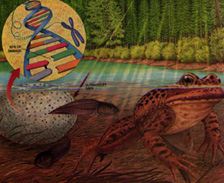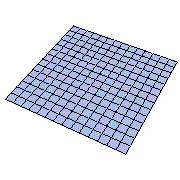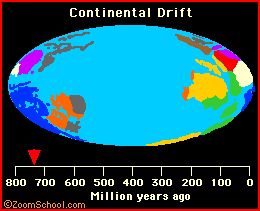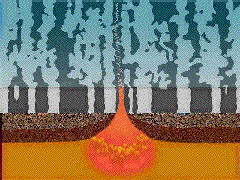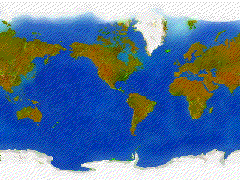Revolutions in the scientific understanding of existence.
Eight wandering bodies about a central star in an endless interstellar space; Andromeda galaxy our nearest neighbor.
A reality check is needed because the planet is better understood, and in trouble.
We are voyagers together on a tiny, tethered, ever turning and transforming, ball of star residue.
Humans first altered land, then landscapes and water, and now the oceans and atmosphere.
- 1700s the character and capacity of the land (1798), the terrain changed.
- 1800s then landscapes and watershed by water and air pollution (1864), the watersheds changed.
- 1900s oceans and atmosphere (1958). the planet's physical greenhouse and climate changed.
outline of argument | meaning | content | what happened? | an example | conclusion
A. defining terms -- Revolution
an abrupt change in basic ideas, whose pattern of relations form the underlying order in any discipline, period of history, or set of circumstances when a profound overturn of older ways of belief and behavior are replaced by discernibly different beliefs and behavior.

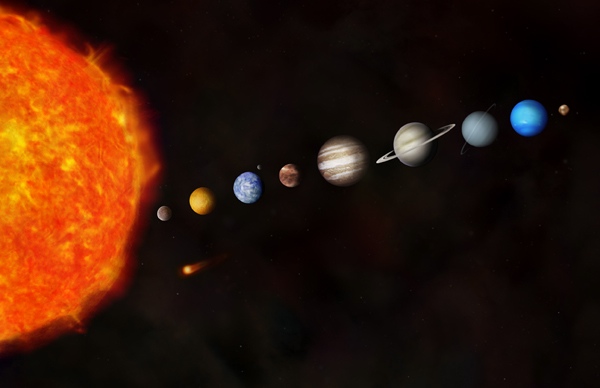
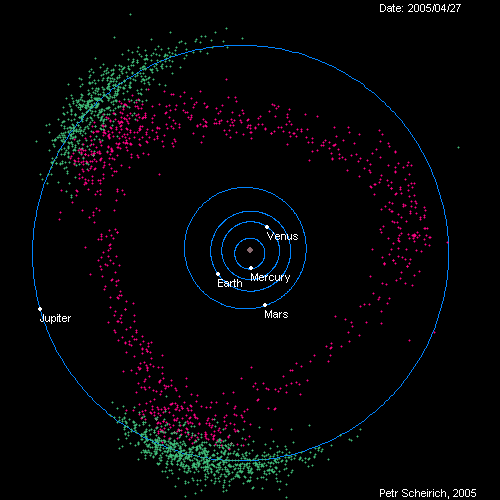
Our sun is a star with its orbiting planets –called wanderers in Greek– that are the bodies in the solar system derived from the sun.
A.1. Literally - meaning changes in thought such as: Galilean 1610s, Newtonian 1680s, Darwinian 1860s, Einstein 1920s, Biological, 1950s.
a. Internal view, who held leading theories and how they were challenged, defended and altered in the experimental & theoretical realms. Kuhn
b. External view, the prevailing events, ideas, people and social movements that shape a culture or disturb a society over time.
b.i. social influences on scientists
- Calvinist Puritanism on Newton
- Thomas Malthus, Adam Smith, & Herbert Spencer on Darwin & Wallace
- Charles Lyell the slow imperceptible, uniform changes
b.ii. Many scientists' ideas have greatly influenced society
- Newton’s and Descartes' “mechanistic” ideas
- Spencer’s and Fisk’s “social Darwinism”
- Kropotkin’s and Ward’s “reform Darwinism”
- Bateson's genetics and Galton’s “eugenics”
outline of argument | meaning | content | what happened? | an example | conclusion
A.2. Figuratively: meaning watersheds, which are divides; milestones are markers that both stand for the events and the means by which these watersheds, or vast intellectual chasms intrude to separate long, static periods when thoughts do not change.
These revolutions as watersheds or chasms reveal the extent and the profoundness of how ideas are reshaped because concepts erupt dividing one generation's beliefs from its ancestor's dogma. These divisions so alter the interpretations each subsequent group holds, that in retrospect we call them complete turn around in beliefs. Thus the term revolutions has been used to describe the impact of new discoveries on science and society.
Such discoveries and translations of the physical, geological, and biological conditions of existence and their impressions are influenced by prevailing beliefs that are altered from one age to another by new findings or radical interpretations of older findings reconsidered in a new light. Finding the Moons of Jupiter with a telescope, or predicting the reappearances of periodic comets, or describing fossils of extinct organisms are examples of just such discoveries that trigger changes in ideas.
The more profound the change and the more widespread the application of that discovery to a spectrum of explanations and interpretations, the more likely it is to be labelled revolutionary. The discoveries and subsequent descriptions of subatomic particles in physics, or of plate tectonics in geology, or of the DNA and RNA helices in biology are such examples.
for instance:
“Wilderness is a metaphor of unlimited opportunity.... not just the body but the spirit”
B.
Three sequences if discoveries in the life sciences to understand the fullness of a paradigm change this metaphor occurred over 150 years.
B.i. past: Charles Darwin & Alfred Wallace, T. Huxley, Mendel (1859)
B.ii. recent: M. Wilkins, J. Watson, F. Crick, Rosalind Franklin (1953)
B.iii. current: Lynn Margulis, Lewontin, Wilson & Ernst Mayr (1980-2010s)
outline of argument | meaning | content | what happened? | an example | conclusion
2. Case of mistaken classifications:
The species as a group & individuals as group members are a taxonomic problem that won’t go away.
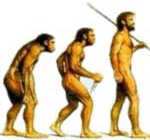
A. “English Trio" , Darwin, Wallace, & Huxley– variation & common descent: naturalists / botany, zoology, bacteriology.
B. Bionic Quartet, Wilkins, Crick, Franklin, Watson– life’s molecular structure: geneticists / molecular biology.
C. “Contemporary Quintet”, Haldane, Wilson, Mayr, Schaller & Gould– fusing of the twin traditions evolutionary development
- genetics,
- five kingdoms,
- mismanagement,
- speciation,
- sexual selection &
- extinction.
outline of argument | meaning | content | what happened? | an example | conclusion
Two lines of research had to become fused. One started by naturalists in the 1850s looked at territory, shape, and behavior, while the second looked at traits, genes, and laboratory behavior becoming the science of genetics after 1900. Darwin and Mendel are convenient names that serve as markers for this split in focus that had to be conjoined in the 1940s-1970s.
Edward O. Wilson argues that the crucible of life can be resilient under certain optimal conditions because it has more than one adaptive strategy to deal with opportunities arising from the differential reproductive and survival rates of the biotic communities members. (ecosystems)
Genetics and ecology inform each other.
4. A framework for a new understanding of life:
The bio-game is a statistically stochastic and contingent “play” where the field is described as a wide or narrow fitness contour. That means the capacity for adjustment to any altered conditions is called fitness. Of importance is the dice (genes) used in this game are chromosomes that have different “norms of reaction” for creating proteins used by living creatures.
Every living member of the biological community participates, thus shaping and being shaped by the playing field, the necessary practice schedule, and the eventual outcomes of these games.
Ecosystems are shifting associations of plants and animals, bacteria, fungus and viruses that functionally share essential nutrients in an ever revolving fund of residual properties needed by all life. Ehrlich
outline of argument | meaning | content | what happened? | an example | conclusion
to the explicit & implied meanings of conceptual revolutions.
A. The scientific revolution 1540-1740, was a two centuries-long move away from Aristotle’s coherent worldview.
This change was characterized by empiricism replaces mere logical rationalism as a means of acquiring knowledge.
During the period an accumulating number of investigations of matter, material things, led to a heuristic manner of proof.
Sophisticated new mathematical formulations were developed & could be used for testing assumptions drawn from observations.
Numerical characters, Roman numerals were replace by Arabic numerals of East Indian origins for ease of calculation.
Algebra and Calculus, Islamic advances in calculation and new formulas from Newton & Leibniz spread.
Euclidean & Non-Euclidean geometry, were developed from Descartes' to Gauss' lifetimes.
Number theory
Binary algebra
Computation
Cryptography
Law of the Conservation of matter (Lavoisier) "Matter can neither be created nor destroyed, just altered."
Laws of Thermodynamics
I. Matter and energy can neither be created nor destroyed.
II. When you transform one form of energy into another there is a reciprocal decrease in efficiency and increase in heat (called entropy or the measure of disorder).
III. The eventual accumulation of disorder or entropy will trigger an end to this universe in the far future.
Four (unified into three) fundamental universal forces: [four forces underlying immediate causes]
Gravity or space warping around massive objects
Electromagnetic fields and the radiant energy spectrum
Weak nuclear force of radioactive decay (fission), emission of radiant energy
Strong nuclear force and the curve of binding energy (fusion) – star behavior
Geology, first in the 1780s and stratigraphy in the 1800s became evidence for a new the theory of continental drift in the 1900s that was verified by geochemistry & geophysics in the 1960s.
All life descends from a common ancestor by means of selective pressure on fortunate survivor populations with anomalies arising from small groups (“founder effect”), bottlenecks (environmental stress), and genetic drift (the tendency of genes to vary around an established but alterable form.).
outline of argument | meaning | content | what happened? | an example | conclusion
The river's mouth is called an estuary. Estuaries are often confusing places called ecotones but reveal the scope and details of these examples of revolutions (B-D above).
Siry, Marshes of the Ocean Shore The Naturalist’s Legacy: seeing with new eyes the contingent and limited response range of an ecotone:
a. evolution including both changes over time and stasis interrupted
b. ecology refers to changes in space, over distance, and trophic dynamics (nourishment strategies) that lead to dispersal
Earthly life is a self-perpetuating assembly constantly altering and being altered by the surrounding materials of existence.
Encoding the earlier conditions of existence into the organism's genes, the chromosomes store molecules that are the means by which creatures can adjust to unexpected and ever shifting situations of material existence. Capra, Gell-Mann, Mayr and Wilson
outline of argument | meaning | content | what happened? | an example | conclusion | lessons
“What we do to the earth, the seas, the skies and the wildlife we do ultimately to ourselves and one another because contingent reciprocity is an inherent fact of existence."
By restating the laws of thermodynamics in a biogeographical sense.
"All actions have consequences in different places over time.”
"The is no place to go in order to survive as we do here on earth."
"Nature always has the last shot to play in the game."
Therefore:
"together on a tiny, tethered, ever turning and transforming,"
J. Siry, 2003, 1014
outline of argument | meaning | content | what happened? | an example | conclusion | lessons
